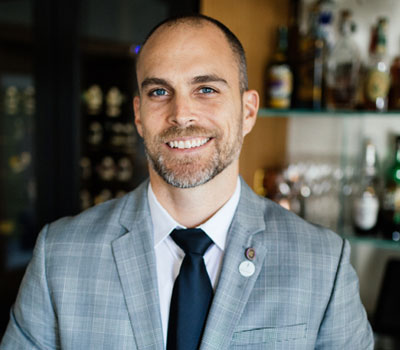Daniel Veit grew up in a restaurant family in Philadelphia, which he left for a short career in tech (“the map field,” he says, “which fueled a fascination for wine places, too.”) He ended up in Santa Barbara working in the wine business—including a stint at Les Marchands, the wine bar and retailer—before heading to L.A. to be closer to the country’s more dynamic wine market. Now in Malibu, he oversees the wine program at the waterfront Carbon Beach Club located at the Malibu Beach Inn.


I thought it was an unusual list, for the Beach. I expected something more conventional.
We’re located in a small boutique hotel, and we get a lot of international travelers, many of whom are familiar with wine. So, we spend less time explaining things; we get people who understand Burgundy, who are familiar with Champagne, with Sancerre, with French wine in general. So, I can afford to be a little more adventurous here than I would in other hotel settings.
Your most successful new wine was surprising: a pelaverga.
Well, it’s at a great price point, and it’s a chillable red that everyone can get down with. The whole somm community is excited about cru Beaujolais, and has been for a lot of years, but pelaverga has many of the same qualities: it has the weight of pinot noir with the acidity you expect from Old World wines and this intense savory character that people aren’t used to.
What percentage of your list is sourced from auction?
About 20 percent. I think showing people that wines have the potential to age, that a wine has this sort of lifespan when it’s older, is important. They often perform better at the table. It’s like a symphony; it starts when you pull the cork, has moments of flourish, dramatic segments within the piece; it can sometimes start out austere and it transforms, becomes mellow and tame.
I’m trying to get people hooked on mature chardonnay. Latour will sell us back vintage offerings, Bouchard as well, and I can sometimes find old Montelena through auctions. The other thing about old wine—old-school wine—is the story. We carry the Heitz Martha’s Vineyard cabernet sauvignon because it’s really good wine, but also because it’s basically the first single vineyard bottling. It’s an iconic wine, with a story.
Storytelling seems almost to be part of how you organize the list.
Maybe. We try to make it a geography lesson, a subtle one. We will list wines north to south, Napa on down to Paso, for example. It’s more a geographical reference as opposed to price. With Champagne, it’s more about style. If it was up to me, if it was my place, I’d organize the list by weight or by texture. But, we fall back on stories.
Any surprises?
The thing that has surprised me this year is that people seem to be less price sensitive. I’m pouring the Vacheron [Domaine Vacheron Sancerre Chambrates] by the glass at $29, and the price doesn’t seem to matter for most people; I’ll pour it until I can’t get any more.
We did really well with this producer from Sicily, Murdo. Their spumante brut rosé really crushed it for me; it was the perfect brunch wine. And you know that Patrick Bottex Bugey-Cerdon, the pet nat? We used it in a cocktail all summer. Integrating good wines makes for good cocktails.
We sold more syrah than I thought we would, and I was surprised by that. I think it sort of comes down to the producer, but there too we had different styles. We had Piedrasassi [from Santa Barbara County] for a cooler style and Villa Creek for those who like that Paso power. We also poured Qupe, the Bien Nacido Hillside, by the glass. It was huge, such a good wine.
Patrick J. Comiskey covers US wines for Wine & Spirits magazine, focusing on the Pacific Northwest, California’s Central Coast and New York’s Finger Lakes.
















